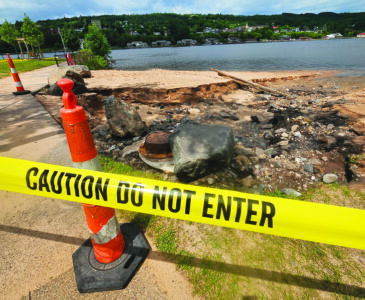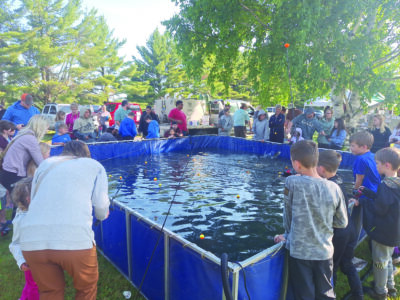Fort Wilkins again receives attention

(Graham Jaehnig/Daily Mining Gazette) Wayne Lusardi, the state of Michigan maritime archaeologist with the Department of Natural Resources, conducted an underwater shoreline visual survey of Lake Fanny Hooe at the Fort Wilkins State Park Saturday. The purpose of the survey was to find any artifacts related to the former military post.
COPPER HARBOR — Fort Wilkins State Park was the subject of an underwater archaeology survey Saturday, or more accurately, Lake Fanny Hooe, on the southern boundary of the former military post.
Wayne Lusardi, the state of Michigan maritime archaeologist with the Department of Natural Resources, said the underwater shoreline visual survey is to see if there are artifacts related to the fort, what types of materials they may be, and their distribution across the lake floor.
“We’re working with volunteer divers,” said Lusardi, “and working back and forth in parallel lines with the shore.”
Photographs were taken of any finds, their precise location was mapped using GPS coordinates, for future analysis. Unfortunately, the survey did not reveal much of significance to the occupation of the post, which was occupied twice: from 1844-1846, during its construction phase, and again from 1867-1870, as a post where disabled combat soldiers of the Civil War served out their enlistments, after having been transferred to the Veterans Reserve Corps, nicknamed the Invalid Corps.
“We’ve found broken glass, a lot fishing tackle, a lot of modern beer cans,” Lusardi said, “along with a couple of pieces of white ceramic that might well be from — they’re 19th century materials; I don’t know if it’s early 1840s or 1860s, but just little fragments of ceramics.”
Lusardi said there also features in the form of the remains of a dock that was once located on the edge of the parade ground. Barry James, historian with the Michigan History Center and Michigan Iron Industry Museum, said the presence of a dock is confirmed in old photographs and was built during the restoration of the fort in the 1930s.
“There is a big timber crib,” Lusardi said, “which basically looks like a big Lincoln Log box, it’s filled with rocks, and there footings for docks and piers, and things like that.”
There is the one timber crib, which is still complete, he said, and a pile or rocks nearby, suggesting the remains of a second one, but it lacks the timbers.
Fort Wilkins State is not only significant to local and state history, it is also significant to the history of the Northwest frontier. The fort tells the story of life on the northern frontier during the mid-1800s. Within the State Park are also the Copper Harbor Light Houses built in 1866 and 1868, which are important to interpreting the early history of maritime navigation on Lake Superior.





